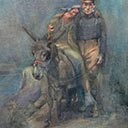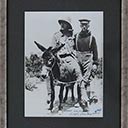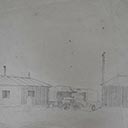Simpson and His Donkey
34 x 28 cm
est. $150,000 - 200,000
This World War I painting by Horace Moore-Jones shows a stretcher bearer supporting a badly wounded soldier perched astride a donkey. He is bringing him down a narrow winding path from the cliffs above ANZAC cove to a casualty clearing station. It is an action that probably saved the life of the soldier and it epitomises not only the horror and sacrifice of that disastrous campaign, but also the heroism and 'mateship' of those who served. Here the stretcher bearer is portrayed as the 'good Samaritan'; the religious imagery is deliberate, particularly as Simpson lost his life bringing one of the wounded back to the beach.
In 1917 Moore-Jones toured the country giving lectures supported by his paintings and lanternslides of the Gallipoli campaign. He frequently made mention of the stretcher bearers like Simpson who had so bravely brought the wounded men from the frontline, and said how sad he was that he did not have an illustration of them. In Dunedin he was approached by Mr G.F. Jackson whose brother, serving on Gallipoli, had sent him a photo of a stretcher bearer using a donkey to carry the wounded. Moore-Jones almost immediately turned this photo into a painting which is now probably the version in the Aigantighe Art Gallery in Timaru. Further versions followed and two of them were sent to London to be made into lithographs.
Reproductions of the painting were popular in both Australia and New Zealand and by late 1915 stories began circulating of how Simpson had risked his own life to help his fellow soldiers - he had become a folk-hero. It was not until the 1930s that the Australians started to question the identity of the stretcher bearer - fellow soldiers in Western Australia said that their Simpson was a different man. Eventually James Jackson, the man who had taken the original painting admitted the man in the photo he had taken was Dick Henderson, an Auckland school teacher. Neither Jackson nor Henderson had spoken up earlier because they believed it would destroy the message of the painting. Moore-Jones who died in a Hamilton hotel fire in 1922 believed that he had painted Simpson.
This version of 'Simpson' and his donkey was in the same family hands until sold in 2008 to the current owner. The figures of 'Simpson', the wounded soldier and the donkey are very clear, because they are painted against a blue background. This serves to focus attention on the trio arranged in pyramid shape almost like a Renaissance study of the Pieta. The soldier and his donkey tread a narrow path on the edge of a steep precipice carrying the wounded; it's the narrow ledge between life and death, which Simpson by his brave actions is defeating.
Moore-Jones was studying art in England in 1914 and enrolled in the New Zealand Expeditionary Force shortly after the war started. He was 47 years old and shaved off his greying moustache and darkened his hair so that he appeared younger. He enlisted as a 32 year old. He was sent to Egypt to train as a sapper, but soon after he landed on Gallipoli he was found sketching the landscape and was ordered to present himself and his sketches to Lieutenant-General Birdwood. He recognised that Moore-Jones could make the topographical sketches he so badly needed for his artillery to fire accurately. Until Moore-Jones was invalided in late November 1915, his role was to sketch and paint the landscape of the peninsula.
Moore-Jones was always known as 'Sapper', even when he was in London in 1916 where his paintings were displayed and he gave a private audience to the King and Queen. That was his choice. He wanted to remain in the ranks to offer comfort to the sick and wounded while working as a field artist. When the possibility of a commission was raised, he reputedly replied, "Imagine an old chap like me trying to be a Lieutenant."
Jennifer Haworth: Author of Behind the Twisted War - A Study of New Zealand Artists in World War I & The Art of War - New Zealand War Artists in the Field 1939 - 1945. Wily Publications





